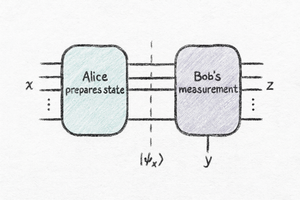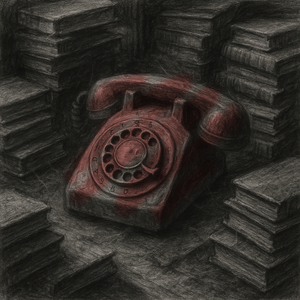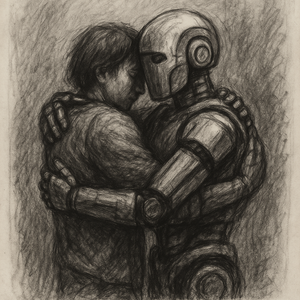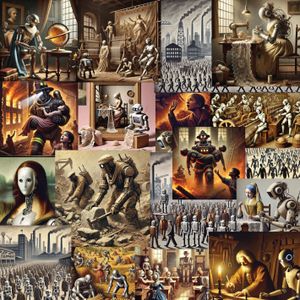AI and Creativity: Inspiration, Reuse, and the Value of a Copy
Introduction: The Spark of Inspiration
Inspiration rarely arrives in a vacuum. Whether it’s a young musician riffing on a jazz standard, a painter reinterpreting a classical motif, or a coder learning from open-source projects, creativity often begins with reuse. The act of drawing from existing material is as old as art itself. What changes over time is how we frame, legalize, and value that reuse. With the emergence of artificial intelligence as a generative force—capable of remixing, sampling, or outright imitating existing content—we’re now faced with urgent and nuanced questions: What constitutes fair use? Where does value reside in a copy? And what, if anything, makes a human touch indispensable?
Echoes Through Time: Reuse as a Creative Tradition
Long before sampling in hip-hop or the mashup culture of DJs, reuse was an embedded part of artistic practice. Classical composers borrowed and varied one another’s themes as acts of homage or as starting points for innovation. Painters, sculptors, and even architects have revisited familiar forms, breathing new life into old symbols. These acts weren’t viewed as theft but as dialogue across generations.
Fast forward to the modern era and remix culture is everywhere. In music, visual arts, film, and design, the reuse and transformation of existing content isn’t just common—it’s a vital form of expression. Yet as we digitize and scale up this process, the line between inspiration and infringement becomes blurrier.
What Is Fair Use?
Legally, “fair use” is a doctrine that permits limited reuse of copyrighted material without permission, under specific conditions. These conditions generally assess:
- The purpose and character of the use (e.g. educational, transformative, commercial)
- The nature of the original work
- The amount and substantiality of the portion used
- The effect of the use on the market for the original
But fair use is not a formula—it’s a flexible, case-by-case consideration. For artists and creators, this flexibility is both a blessing and a burden. AI-generated works further complicate this, as they can be trained on enormous corpora of copyrighted material. When an AI writes a poem in the style of Sylvia Plath or generates an image that looks uncannily like a Van Gogh, is that inspiration, imitation, or infringement?
Value: Original vs Copy
To explore these questions, we need to unpack the idea of value.
Why is a Stradivarius violin worth millions while a factory-made violin is a few hundred dollars? Not because the sound is infinitely better (though some might argue so), but because of provenance, rarity, and craftsmanship. It’s the aura of the original—the hand of the maker, the time and place of creation, the story embedded in the object.
Similarly, a live performance holds more emotional and economic value than a recording. Part of this is scarcity (you had to be there), part is energy and presence, and part is the shared, communal aspect of the moment.
In contrast, a copy or remake might be more accessible, reproducible, and widely consumed—but it often lacks that unique aura. Digitalisation adds another layer to this equation: a digital copy—whether in raw form, enhanced, or compressed (like a RAW file versus an MP3)—can fundamentally change both the creative value and the economic realization of a work. A digitally compressed audio file might reach millions via streaming platforms, but it may lack the richness of a high-fidelity master. Similarly, artists once relied on physical album sales for income; today, they often navigate micropayments per stream. Yet, paradoxically, a copy—whether digital or reinterpretive—can still transcend the original in cultural resonance, finding new relevance or popularity in an entirely different context.
When the Copy Becomes the Classic
Some of the most iconic songs in history are covers or remakes:
- Aretha Franklin’s “Respect” is arguably more powerful and enduring than Otis Redding’s original. Her interpretation transformed a plea into a feminist anthem.
- Cyndi Lauper’s “Girls Just Want to Have Fun” began as a more cynical track by Robert Hazard. Lauper’s version flipped it into a joyful declaration of agency and fun.
- Miley Cyrus’ “Midnight Sky” inspired a now-famous mashup with Stevie Nicks’ “Edge of Seventeen,” resulting in “Edge of Midnight”—a cross-generational blend that reached audiences who may not have known either track in isolation.
These examples show that re-recordings and reinterpretations can bring new voice, new meaning, and new value. They demonstrate that the process of reuse is not just about duplication; it’s about transformation.
AI: Remixing at Scale
Now enter AI.
Large language models, generative adversarial networks, and diffusion-based systems are trained on vast datasets of human work. What they produce is not copied in a literal sense, but heavily shaped by what they’ve ingested. A generative AI trained on thousands of jazz tracks can create something that sounds like jazz, just as a student steeped in jazz might. But the AI has no context, no struggle, no lived experience. Is it still creative?
On the one hand, AI can help democratize access to creativity. An aspiring filmmaker can use AI to generate storyboards or score music. A child can co-create illustrations. A scientist can prompt new visualizations. AI is a tool—like Photoshop, a synthesizer, or Auto-Tune.
On the other hand, when AI creates something that feels original but is subtly derived from billions of human artifacts, the question of value becomes tricky. Who owns it? Who deserves credit? And what is it worth? The issue becomes even more complex when we consider scale. Is it truly “fair use” when companies can train massive AI models on countless copyrighted works without compensating their creators, and then commercialize the outputs as proprietary intellectual property? While individuals are held to nuanced and often strict standards of fair use, corporations increasingly benefit from ambiguous legal territory, building immense value from collective cultural labor. This disparity raises fundamental questions not only about legality but about equity, authorship, and the ethics of knowledge production in the age of generative AI.
Beyond Originality: The Value of Curation and Context
We tend to conflate originality with value, but this isn’t always fair. Curators, DJs, and editors aren’t creating from scratch, but they add immense value by framing, selecting, and combining. The same applies to prompt engineers and digital artists using AI.
Moreover, the audience plays a crucial role in assigning value. A TikTok remix might feel throwaway to one person and life-changing to another. Cultural value is not objective; it’s relational. This leads us to an important distinction that has emerged more sharply in the digital age: the difference between “art” and “content.” Art is often framed as intentional, crafted, and reflective—something meant to evoke, challenge, or endure. Content, by contrast, is typically understood as transient, algorithmically distributed, and optimized for clicks, shares, or views. Yet the boundary between them is porous. A YouTube video can become art; a gallery piece can be memefied into content. Digital platforms blur these lines, sometimes flattening value, other times amplifying it. What matters increasingly is not just what something is, but how it’s received, circulated, and contextualized by its audience.
Reuse as Cultural Memory
Every act of reuse is an act of remembering. Whether it’s a classical motif in a film score or a
In this sense, AI’s vast sampling capacity isn’t unprecedented—it’s just faster and wider. The real question is not whether reuse is okay, but how we ensure it remains respectful, transformative, and enriching rather than extractive.
Conclusion: Toward a Symbiotic Future
Creativity is not a solo act—it’s a continuum. AI challenges our notions of authorship, but it also invites us to think more deeply about what makes human creativity special: context, emotion, intention.
If we view AI not as a rival but as a collaborator, we might develop new forms of expression that blend the best of reuse and originality. And as we continue to wrestle with legal, ethical, and philosophical questions, one thing remains clear: the most valuable copies are those that bring something new to the table—a new voice, a new lens, a new emotion.
Inspiration has always been a remix, but when it comes to the use of AI we still have to figure out who is playing who. Is AI the instrument or is it playing us?




